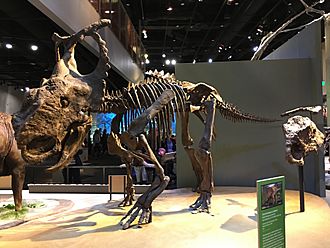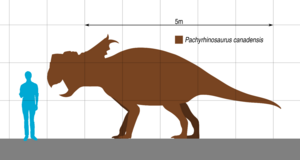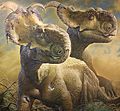Pachyrhinosaurus facts for kids
Quick facts for kids Pachyrhinosaurus |
|
|---|---|
 |
|
| P. perotorum mounted at the Perot Museum | |
| Scientific classification |
|
| Kingdom: | Animalia |
| Phylum: | Chordata |
| Clade: | Dinosauria |
| Order: | †Ornithischia |
| Family: | †Ceratopsidae |
| Subfamily: | †Centrosaurinae |
| Clade: | †Pachyrostra |
| Genus: | †Pachyrhinosaurus Sternberg, 1950 |
| Type species | |
| †Pachyrhinosaurus canadensis Sternberg, 1950
|
|
| Species | |
|
|
Pachyrhinosaurus (say "Pack-ee-rye-no-sore-us") was a big, plant-eating dinosaur that lived a long, long time ago. It had a special bony frill around its neck, four short legs, and a short tail. This dinosaur was a type of ceratopsian, which means it was related to dinosaurs like Triceratops. Pachyrhinosaurus could grow to be about 18 to 23 feet (5.5 to 7 meters) long. Instead of big horns, it had many small, rough bumps on the middle of its frill.
What Did Pachyrhinosaurus Look Like?
Pachyrhinosaurus was quite large, reaching about 20 to 26 feet (6 to 8 meters) in length. It weighed around 3 to 4 tons, which is as heavy as a large truck! These dinosaurs were herbivorous, meaning they only ate plants. They had very strong teeth in their cheeks, perfect for chewing tough, fibrous plants.
Instead of pointy horns, Pachyrhinosaurus had thick, flattened bumps on its skull. There was a big bump over its nose and a smaller one above its eyes. It also had a pair of noticeable horns that grew upwards from its neck frill. The skull had other smaller bumps or decorations that were different for each individual dinosaur and even between different species.
Scientists use these different bumps on the nose to tell the various species of Pachyrhinosaurus apart.
Images for kids
-
TMP 2002.76.1, which may be a specimen of Pachyrhinosaurus, Achelousaurus, or a new taxon, in Royal Tyrrell Museum
-
A herd of P. perotorum resting next to contemporaneous paleofauna from the Prince Creek Formation
See also
 In Spanish: Pachyrhinosaurus para niños
In Spanish: Pachyrhinosaurus para niños











